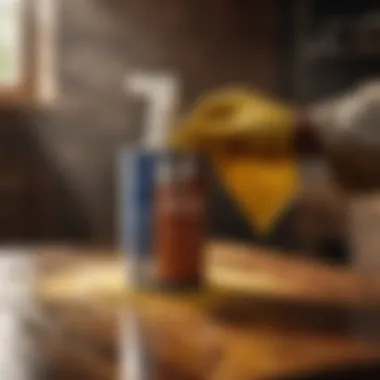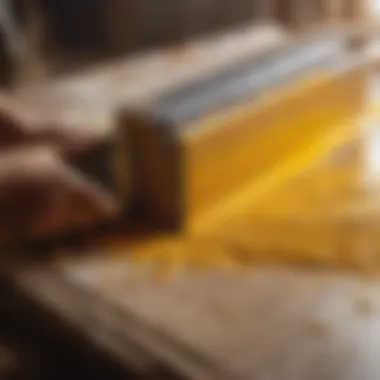Materials:
- Xylene based chemical paint remover: 2 gallons
- Plastic drop cloths: 3 sheets (10ft x 12ft each)
- Safety goggles: 1 pair
- Chemical-resistant gloves: 1 pair
- Paint scraper: 1
- Steel wool pads: 2 packets
- Disposable paintbrushes: 3
- Respirator mask: 1
- Clean rags: 10
- Bucket: 1
DIY Steps:
-
Preparation: Begin by laying down plastic drop cloths to protect the work area. Put on safety goggles, chemical-resistant gloves, and a respirator mask for protection.
-
Apply Paint Remover: Using a disposable paintbrush, apply the xylene-based chemical paint remover generously onto the painted wood surface. Ensure complete coverage.
-
Wait and Scrape: Allow the remover to sit for 20-30 minutes to loosen the paint. Use a paint scraper to gently scrape off the softened paint layer.
-
Steel Wool Finish: For stubborn spots, use steel wool pads to effectively remove remnants while being gentle on the wood surface.
-
Clean Up: Wipe down the wood with clean rags to remove any remaining paint residue and chemical residue.
Technical Aspects:
- Timing: Ensure the paint remover sits for the recommended duration for optimal efficacy.
- Tools: Utilize a paint scraper and steel wool pads for different stages of paint removal.
- Techniques: Apply the remover in even strokes and avoid excessive scrubbing to prevent damage to the wood.
DIY project Process:


- Detailed Installation method: Start by applying the paint remover in a small inconspicuous area to test for compatibility before proceeding with the entire surface.
- Key Techniques and timings: Work in small sections to manage the removal process effectively without compromising results. Avoid leaving the remover on for too long to prevent damage.
- Troubleshooting Tips: If the paint doesn't come off easily, reapply the remover and let it sit for a few more minutes before scraping again.
This comprehensive guide on chemical paint removers for wood ensures a successful paint stripping project with attention to safety and effectiveness.
Introduction


In the realm of woodwork and DIY projects, the choice of chemical paint remover holds significant weight in determining the success of a paint stripping endeavor. The Introduction section serves as the gateway to comprehending the nuances and intricacies of chemical paint removers for wood. Readers will embark on a journey of discovery, delving into the essential aspects of selecting the right remover, preparing surfaces effectively, mastering application techniques, and executing paint removal with finesse. By grasping the fundamentals outlined in this section, individuals are empowered with the knowledge required to approach paint stripping tasks with confidence and precision.
Understanding Chemical Paint Removers
Understanding Chemical Paint Removers is a pivotal chapter that sheds light on the diverse formulations and functionalities of these potent solutions. From solvent-based removers offering quick stripping capabilities to caustic removers known for their robust paint removal properties, and bio-based alternatives appealing to environmentally conscious users, the section covers a spectrum of choices tailored to various needs. By exploring the distinct characteristics and applications of each type, readers gain a deeper appreciation for the underlying science behind chemical paint removers, facilitating informed decision-making when selecting the most suitable option for their wood surfaces.
Types of Chemical Paint Removers


In the realm of wood restoration, understanding the diverse array of chemical paint removers is crucial for achieving optimal results. This section delves into the significance of exploring different types of chemical paint removers when embarking on a wood paint removal project. By comprehending the specific characteristics, benefits, and considerations associated with each type, one can make informed decisions tailored to the unique needs of their project.
Solvent-Based Removers
Solvent-based paint removers are renowned for their powerful stripping capabilities, effectively lifting multiple layers of paint without causing damage to the wood surface. These removers contain strong chemicals such as methylene chloride or acetone, which break down the paint's bond for easy removal. Users must exercise caution when utilizing solvent-based removers due to the harsh nature of the chemicals involved. Proper ventilation and protective gear are imperative to ensure safety during application.
Caustic Removers
Caustic paint removers, also known as alkaline strippers, are praised for their efficacy in removing paint from intricate wood surfaces. These removers leverage strong alkaline compounds like lye to dissolve paint, offering a reliable solution for stubborn coatings. Caution is advised when using caustic removers, as they can be corrosive to skin and necessitate careful handling. Additionally, thorough surface preparation is crucial to optimize the stripping process when employing caustic removers.
Bio-Based Removers
For environmentally conscious individuals seeking a safer alternative, bio-based paint removers present a compelling choice. Derived from natural ingredients such as citrus or soy, these removers offer a less toxic option without compromising on performance. Bio-based removers are gentle on the wood surface and the environment, making them an ideal selection for eco-friendly paint removal projects. While bio-based options are generally milder than solvent-based or caustic removers, multiple applications may be required for complete paint removal, emphasizing the importance of patience and thoroughness in the process.
Application Methods
In the realm of chemical paint removers for wood, mastering the application methods is crucial for achieving successful results. This section delves into the significance of proper application techniques, emphasizing the pivotal role they play in the paint removal process. Choosing the right method can greatly impact the efficiency and effectiveness of the remover.
When it comes to the application methods, housewives and homeowners must carefully consider their specific project needs and the type of paint to be removed. Factors such as the condition of the wood surface, the thickness of the paint, and the desired outcome should all be taken into account when selecting the most suitable application method.
Moreover, understanding the instructions provided by the manufacturer and following them meticulously is key to ensuring a smooth application process. Whether brushing, spraying, or wiping on the remover, precision and attention to detail are imperative for optimal results.
By addressing the nuances of application methods through detailed explanations and practical tips, this section equips readers with the knowledge needed to tackle their paint stripping projects effectively and efficiently.
Choosing the Right Remover
Before embarking on a paint removal project, one of the crucial decisions is selecting the appropriate chemical paint remover for the job. This subsection explores the key considerations that housewives and homeowners should keep in mind when choosing the right remover.
Considering factors such as the type of paint on the wood, the wood's sensitivity, and the desired stripping method can influence the decision-making process. Solvent-based removers are ideal for tough coatings, while caustic removers are effective against multiple layers of paint. Bio-based removers offer a safer and environmentally-friendly option for those conscious of chemical exposure.
By evaluating the specific requirements of the project and understanding the properties of different types of chemical paint removers, individuals can make an informed choice that aligns with their goals and preferences.
Preparing the Surface
Preparing the wood surface before applying the remover is a critical step in ensuring the success of the paint removal process. This section details the importance of thorough surface preparation and outlines the essential steps to follow.
Begin by cleaning the wood surface to remove any dirt, debris, or contaminants that could interfere with the remover's effectiveness. Sanding the surface lightly can help improve the adhesion of the remover and ensure uniform application. It is also essential to protect surrounding areas and wear appropriate safety gear during this preparatory phase.
By dedicating time and effort to preparing the wood surface adequately, housewives and homeowners set the foundation for a smooth and efficient paint removal process that yields professional-quality results.
Applying the Remover
The process of applying the chemical paint remover is a critical stage that requires precision and care. This subsection guides readers through the steps involved in applying the remover effectively.
Whether using a brush, spray bottle, or cloth, ensure an even and generous application of the remover on the wood surface. Allow an adequate dwell time as per the product instructions to ensure the remover penetrates and softens the paint layers effectively. Monitoring the progress and making adjustments as needed will help achieve optimal results.
By providing detailed instructions on the application process and highlighting best practices, this section empowers readers to approach paint removal confidently and with a clear understanding of the necessary steps.
Removing the Paint
The final stage of the paint removal process involves the actual removal of the softened paint layers from the wood surface. This subsection delves into the various methods and techniques for effectively removing the paint residue.
Using scraping tools, steel wool, or abrasive pads, gently remove the softened paint while taking care not to damage the wood surface. It may be necessary to repeat the application and removal process for stubborn or multiple layers of paint. Once the paint is completely removed, clean the surface thoroughly to reveal the natural beauty of the wood.
By providing insights into efficient paint removal techniques and emphasizing the importance of patience and precision, this section prepares housewives and homeowners for the final steps of the paint stripping process.
Safety Precautions
In the realm of chemical paint removers for wood, safety precautions play a paramount role, ensuring a successful project while safeguarding one's well-being and the environment. Prioritizing safety precautions is not just a recommendation but a necessity to mitigate potential hazards and health risks associated with these potent substances. Understanding and implementing safety measures can prevent accidents and promote a smooth paint removal process.
Protective Gear
When embarking on a paint-stripping project using chemical removers, equipping oneself with appropriate protective gear is non-negotiable. Essential protective gear includes gloves, goggles, respirators or masks, and protective clothing. Gloves shield the skin from direct contact with chemicals, preventing irritation or burns. Goggles protect the eyes from splashes or fumes that may cause irritation or damage. Respirators or masks ensure inhalation of harmful vapors is minimized, preserving respiratory health. Additionally, wearing protective clothing such as long sleeves and pants provides an added layer of defense against accidental spills or splatters.
Ventilation
Proper ventilation is a critical aspect of safety when working with chemical paint removers. Adequate ventilation helps disperse fumes and vapors generated during the paint-stripping process, reducing chemical exposure and promoting a healthier work environment. Working in a well-ventilated area, preferably outdoors or in a well-ventilated room, allows for the continuous flow of fresh air, minimizing the concentration of fumes in the breathing zone. Utilizing fans or opening windows can enhance ventilation, improving air quality and overall safety.
Disposal of Waste
Disposing of waste from chemical paint removers requires careful handling to prevent environmental contamination and adhere to regulations. It is crucial to follow local guidelines for hazardous waste disposal to ensure proper management of leftover paint residue, used removers, and contaminated materials. Proper disposal methods may include sealing waste in airtight containers, labeling appropriately, and delivering to designated collection centers or hazardous waste disposal facilities. By responsibly disposing of waste, one contributes to environmental preservation and complies with legal requirements, fostering sustainable painting practices.
Best Practices for Paint Removal
In the realm of wood restoration, applying the best practices for paint removal is crucial to achieve exceptional results. This article underscores the pivotal role of employing these practices, highlighting their significance in ensuring a successful and efficient paint stripping process. By adhering to these best practices, both seasoned professionals and DIY enthusiasts can enhance the overall quality of their projects while maintaining the integrity of the wood surface.
Exploring the specific elements of best practices for paint removal unveils a spectrum of benefits. Firstly, conducting a test patch is paramount. This method allows individuals to assess the effectiveness of the chosen remover on a small, inconspicuous area before tackling the entire surface. Additionally, utilizing multiple applications when needed ensures thorough paint removal, especially for stubborn or multiple layers of paint. Finally, neutralizing the surface post-removal is essential to restore the pH balance of the wood and prevent any residual chemical reactions. Embracing these practices minimizes errors, optimizes efficiency, and elevates the overall outcome of the paint removal process.
Test Patch
The process of conducting a test patch serves as a critical initial step in the paint removal journey. This section delves into the importance and methodology of executing a test patch effectively. Before embarking on a full-scale paint stripping endeavor, testing a small area provides invaluable insights into the compatibility of the remover with the wood surface. By selecting an inconspicuous spot, such as a corner or underside of the wood piece, individuals can observe how the remover interacts with the paint and wood without compromising the entire surface.
Establishing the optimal timing for the test patch is key. Following the manufacturer's instructions, apply a small amount of the chosen remover to the designated area and monitor its reaction over the specified time frame. Assessing the remover's efficacy, impact on the wood grain, and potential side effects ensures a controlled assessment before proceeding with the extensive paint removal process. Through meticulous observation and analysis of the test patch results, individuals can make informed decisions and adjustments, fostering a seamless and successful paint removal experience.
Multiple Applications
When confronted with stubborn or multiple layers of paint, employing multiple applications is a recommended strategy to achieve thorough removal. This section delves into the rationale behind utilizing this method and outlines the best approaches to maximize its effectiveness. By reapplying the remover as needed, individuals can penetrate through all layers of paint, ensuring complete dissolution and facilitating a smoother stripping process.
Effective execution of multiple applications involves adhering to specific guidelines. Timing and consistency play a vital role in this process. Waiting for the appropriate dwell time between applications and maintaining a uniform coverage are essential to optimize the remover's action on the paint layers. Moreover, utilizing appropriate tools and techniques, such as scrapers or brushes, aids in the efficient removal of softened paint, enhancing the overall efficacy of the multiple application strategy. Embracing this approach empowers individuals to tackle intricate paint removal challenges with precision and efficiency.
Neutralizing the Surface
Upon successfully removing the paint layers, neutralizing the surface is imperative to restore the wood's pH balance and negate any remaining chemical residues. This section illuminates the significance of neutralization and outlines practical methods to safeguard the wood surface post-removal. By neutralizing the surface, individuals prevent any potential reactions between the wood and residual chemicals, ensuring the longevity and integrity of the refurbished wood.
Implementing the neutralization process involves strategic steps. Utilizing a neutralizing agent, such as water or a recommended solution, individuals can effectively cleanse the wood surface of any remaining remover or paint remnants. Thorough rinsing and gentle scrubbing aid in removing any lingering particles, preparing the wood for subsequent treatments or finishes. By neutralizing the surface meticulously, individuals safeguard the wood against potential damage or discoloration, culminating in a pristine and restoration-ready surface.
Conclusion
In this extensive guide to Chemical Paint Removers for Wood, we have delved deep into the nuances of paint removal, from understanding the various types to mastering the application methods and safety precautions. By thoroughly examining the importance of each element, we offer readers a comprehensive resource to tackle paint stripping projects effectively. One of the crucial aspects highlighted in this article is the significance of selecting the right type of remover based on the specific needs of the project. Whether opting for solvent-based, caustic, or bio-based removers, ensuring the compatibility with the wood surface is paramount for successful paint removal. Additionally, emphasizing the need for proper protective gear, adequate ventilation, and responsible waste disposal underscores the importance of safety when using chemical paint removers. By following the best practices outlined, such as conducting a test patch, applying multiple coats as necessary, and neutralizing the surface post-removal, readers can achieve optimal results with their paint stripping endeavors. This conclusive segment serves as a summation of the crucial considerations outlined throughout the guide, empowering readers with the knowledge and tools required to undertake paint removal projects confidently and effectively.
Final Thoughts
As we wrap up this comprehensive guide, it's essential to reiterate the fundamental principles underpinning successful paint removal using chemical paint removers for wood. The key takeaway revolves around the meticulous planning and execution required for a seamless stripping process. By starting with a clear understanding of the wood surface, selecting the appropriate remover, and meticulously following the application methods, individuals can ensure efficient paint removal without compromising the integrity of the wood. Prioritizing safety measures, such as wearing protective gear, maintaining proper ventilation, and adhering to waste disposal protocols, is instrumental in safeguarding against potential health hazards. Furthermore, incorporating the best practices outlined in this guide, such as conducting a test patch, applying multiple coats, and neutralizing the surface, guarantees a professional finish and preserves the wood's quality. By reflecting on these final thoughts and harnessing the insights shared throughout the guide, readers are equipped to embark on their paint stripping journeys equipped with the knowledge and expertise to achieve optimal outcomes.





